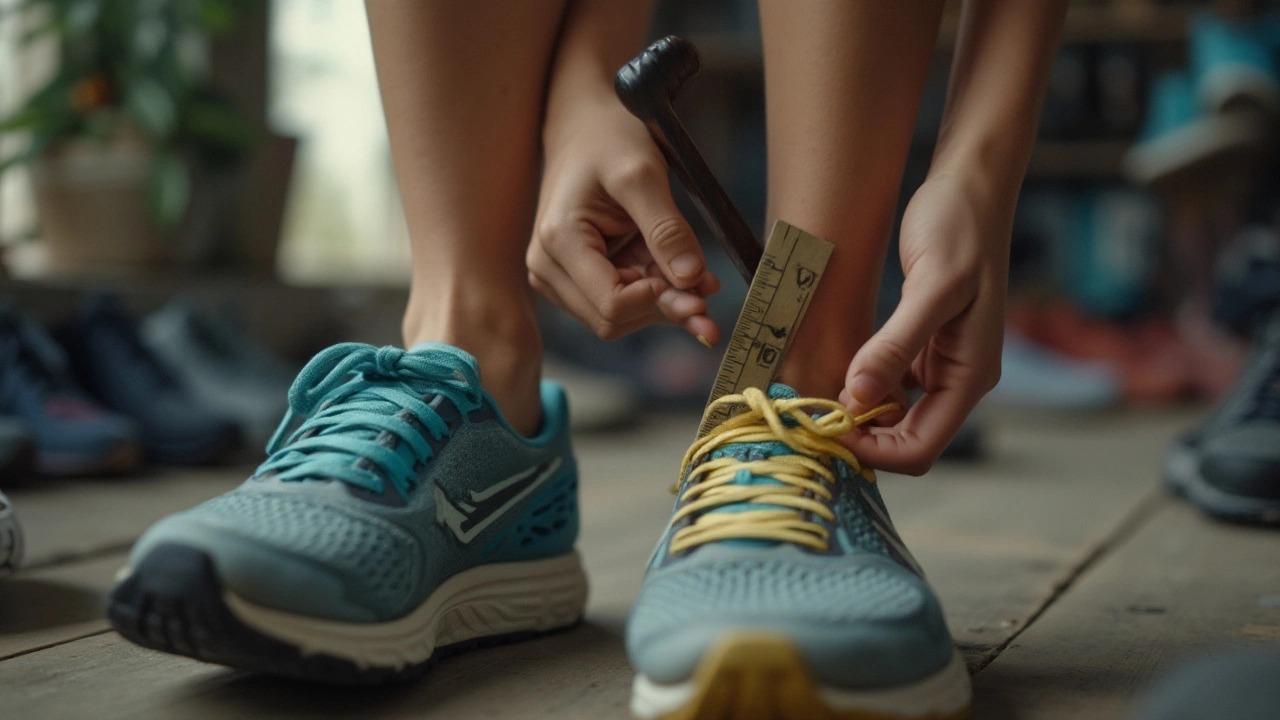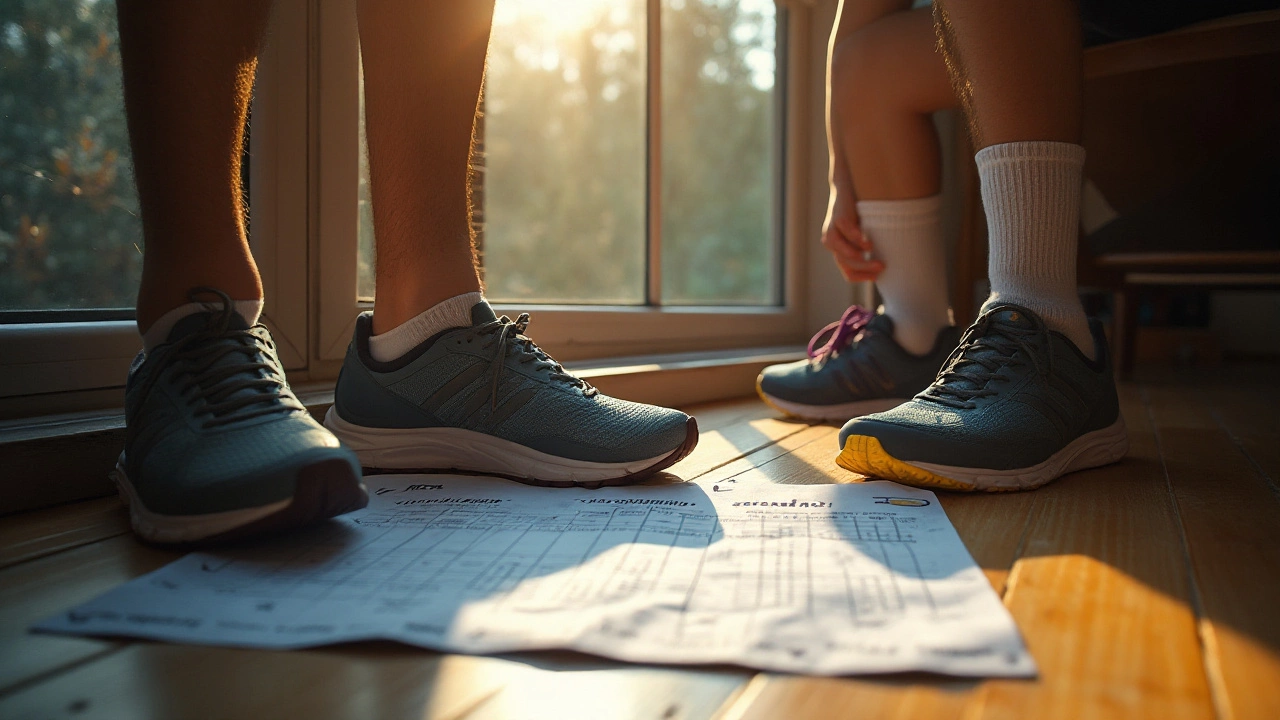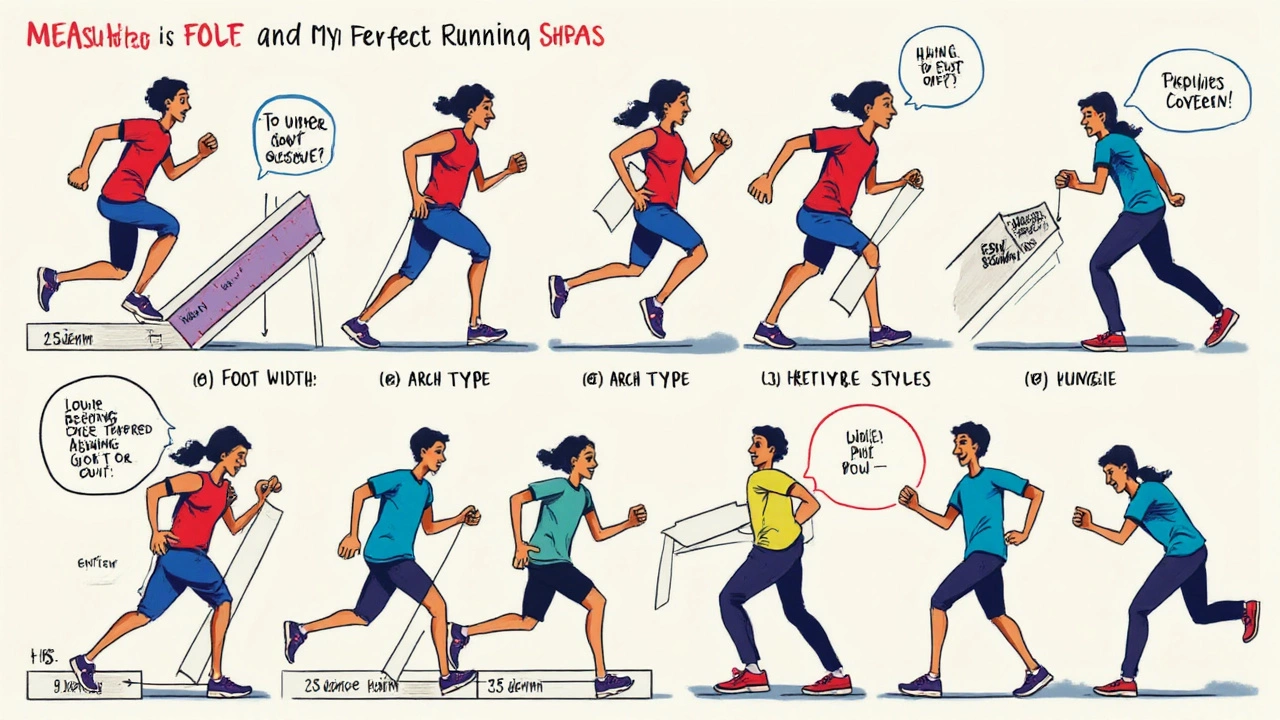Finding the Best Fit: A Guide to Choosing Running Shoe Size

When it comes to running comfortably, finding the right shoe is more than just picking a pair you like. Any seasoned runner will tell you that having the right size is like having the perfect dance partner – it makes all the difference. Not only does it help you avoid injuries, but it also enhances your performance and keeps those blisters away.
Diving into the world of foot measurements and shoe sizes might seem daunting, but a little knowledge goes a long way. Whether you're a beginner or a seasoned marathoner, understanding how to identify your perfect fit is a game-changer. In this article, we'll explore tips and techniques for selecting running shoes that cater to the unique needs of your feet.
- Understanding Foot Measurements
- Deciphering Sizing Systems
- Tips for Trying On Running Shoes
- Beyond Size: Other Factors to Consider
Understanding Foot Measurements
Grabbing the perfect pair of running shoes starts with nailing the right foot measurements. It's about more than just knowing your size; it's about understanding the shape and unique features of your feet, which play critical roles in how a shoe fits and feels. Many enthusiasts fall into the trap of sticking to their 'usual size', but feet can change over time due to factors like age, weight changes, and even the specific activity you engage in. That's why it's essential to revisit your foot size regularly, instead of relying on old measurements.
To start with, measuring your feet is best done at the end of the day. This is when feet have naturally swelled to their largest, thanks to a day's worth of activity. It's a simple process: stand on a blank piece of paper with your heel against a wall, and mark the longest point of your toes. Do the same for the width, and don't forget to measure both feet, as most people have one foot slightly larger than the other. It's always wise to choose the shoe size based on your larger foot.
Now, let’s dive into the nuances of foot width. While length is often what most people consider when choosing running shoes, width plays a significant role too. Shoes come in a variety of widths, from narrow to extra wide, which can make a world of difference in comfort. If your shoes are too narrow, you'll end up with pinched toes and blisters. Too wide, and your foot may injuriously slide around within the shoe. Foot width is easy to overlook, yet vital for finding a snug but comfortable fit.
"Proper foot measurement should take into account both length and width," says Dr. Emily Splichal, a leading podiatrist and human movement specialist. "The aim is to support the foot's natural mechanics, no matter what your running style may be."
Aside from length and width, arch height matters too. You might have high arches, flat feet, or fall somewhere in between. This will affect the way your foot strikes the ground and therefore the type of shoe that's best for you. Those with flat feet often need more stability, while high arches usually benefit from cushioned support. Historically, studies have shown that about 20% of people have low arches, 60% normal, and 20% high arches, emphasizing the importance of understanding your arches when shoe shopping.
If you're unsure about any of these elements, many running stores offer a simple analysis. Or you can try a wet foot test at home: step on a piece of cardboard after wetting your foot and observe the imprint. A full imprint indicates a low arch, while a narrow, curved connection between the heel and toe means a high arch. Remember, this isn't about complicating your purchase; it’s about equipping yourself with the knowledge for the best choice.

Deciphering Sizing Systems
Understanding shoe sizes can feel like navigating a maze, especially with different countries adopting various systems. When buying running shoes, it's not as straightforward as knowing your regular shoe size, because not all brands fit the same. Each brand might add its own unique spin on sizing, which can be perplexing if you're uncertain about the nuances.
Traditionally, running shoe sizes are determined using three primary systems: US, UK, and EU. While all systems aim to give you the same result—a shoe that fits perfectly—they do so in slightly different ways. Understanding these systems starts with knowing that they're based on different measurement units and standards. For instance, US sizes are typically one size larger than UK sizes, so a US size 8 usually equates to a UK size 7.
Interestingly, the European sizing system uses a different approach altogether with lengths measured in Paris points. This method offers a supposedly more accurate fit in terms of width and length because a 'point' correlates to approximately two-thirds of a centimeter. This system, although more uniform, doesn't account for foot width variations, which can make a huge difference in finding your proper fit for comfortable running.
The differences among all the sizing systems can still leave room for error. Some brands even customize their sizing chart to reflect their shoe shape and function. For instance, Asics might fit differently compared to Nike, even at the same size number. This is because of differences in toe box width, heel curvature, and instep height. Oftentimes, manufacturers offer online conversion charts, but trying the shoes in store when possible helps confirm the right size without second-guessing.
Adapting to Running Specific Fits
Then there's the added complication of running shoe-specific recommendations. Experts usually suggest purchasing running shoes half a size larger than your everyday shoes. The reason? Your feet tend to swell during runs, requiring more room. This is one of the critical aspects to remember about shoe sizing to ensure a pain-free, blisterless experience.
Knowing these intricacies can significantly aid in choosing shoes that will truly give you a run for your money. For added depth, considering the insole and even the thickness of the running sock you typically wear can further refine your fit. An often overlooked but important factor is the measurement of both feet since many people have one foot slightly larger than the other, which should ideally dictate the size purchased.
"Selecting the right running shoe size is more than just numbers—it's about understanding how your feet interact with different shoes across brands and recognizing the subtle differences in sizing systems," says Sam Hunter, a running expert from Runner’s World.
Considerations for Different Regions
Be aware that even local variations can exist within the same sizing system, such as between men’s and women’s sizes or children’s shoes. Women, in particular, may find varying recommendations depending on wider or narrower foot shapes addressed by certain brands. This could explain the occasional discrepancy between sizing systems when purchasing cross-regionally. Sometimes specific data, such as from a comfortable running study, illustrates that selecting the right size can incrementally increase enjoyment and performance during a run.
| Size System | US | UK | EU |
|---|---|---|---|
| Foot length (inches) | 10 | 9 | 25.4 |

Tips for Trying On Running Shoes
Trying on running shoes isn't just a quick in-and-out task; it’s a vital ritual that can influence how your next run feels. A well-planned shoe shopping session can save your feet from a lot of discomfort. First, timing is crucial. Experts suggest that you try on shoes later in the day or after a run because your feet swell throughout the day. This ensures you're accounting for changes in foot size that occur when running.
When you head to the store, wear the socks you typically run in and bring any orthotics if you use them. These can affect the fit, and having them with you provides a more accurate assessment of how the shoe will fit during a run. As you try on running shoes, make sure you leave a thumbnail's width of space between your longest toe and the end of the shoe. This space accounts for foot expansion and prevents blisters and toenail issues.
Listen to how your body feels in different shoe sizes and models. The right fit should feel comfortable straight away without needing a break-in period. Take a short jog around the store to see how they feel in motion. Don’t hesitate to try multiple sizes and brands; the fit can vary significantly depending on the shoe's design.
A critical aspect many overlook is the shoe's width. Don't just focus on length. If you feel the sides pinching your feet, this may lead to unwanted pressure points over time. Some retailers offer width variations, especially in popular brands, so don't be afraid to ask. Remember, a great fitting shoe doesn't just look good; it hugs every part of your foot evenly without tightness or pinching.
Test the Cushion and Support
Many runners wonder about the shoe’s cushioning and support. It’s not just about how soft they feel but how they support your arch and stride. A useful method is the 'press test': while wearing the shoe, press down on the midsole with your thumb. This helps determine if it offers enough resistance and responsiveness. A shoe that's too soft might be comfortable initially but can translate to poor performance and faster wear down.
Here's a tip that might surprise you: walk barefoot along the store aisle first to understand how your foot responds naturally. You may notice certain tendencies like overpronation or supination, which impacts what type of shoe may be most suitable. According to Runner's World, ''Your running shoes should have a natural flexibility that lets you move organically but still provide stability.'' This flexibility helps you maintain proper form and prevent injuries.
Lastly, trust your instincts. If it feels slightly wrong when you’re trying them on, it might not get better. Your aim is to find a shoe that feels great right off the bat, supporting you as you hit the track, trail, or treadmill.
Don’t forget, behind every pair of extraordinary running shoes lies the crucial test of trial and error. Take your time, trust the feedback from your feet, and you’ll find the perfect partner for your run.

Beyond Size: Other Factors to Consider
While the size of your running shoes forms the foundation of a comfortable fit, it's crucial to remember size isn't the only factor to consider when lacing up for your next run. One key element to think about is the shoe's intended purpose. Different activities demand different shoe specifications. For instance, trail running needs a shoe with more grip and protection compared to road running shoes that emphasize lightweight and cushion. Each shoe is specifically designed to meet the needs of the activity, helping you perform better and avoid injuries. Understanding this element can dramatically shift your perception of what your foot feels in a shoe.
Another aspect worth pondering is the arch support your feet require. Not everyone has the same arch type, making it vital to know whether you're flat-footed, have a neutral arch, or high arches. Your arch type affects how your foot strikes the ground and distributes pressure, thus influencing the need for stability or additional arch support in your shoes. A podiatrist or a specialty running store can often help evaluate your foot's arch type, leading you to models that prevent unwanted stress on your joints and muscles. These subtle cues can make a world of difference in how you experience every pace and stride.
Pay close attention to the material and technology employed in your shoe choice, too. The right material can enhance breathability, waterproofness, and durability of your running shoes. For example, advanced mesh designs offer excellent ventilation, keeping your feet cool during long runs, while newer foam technologies provide better cushioning and energy return with each step. The use of such innovative materials and designs can directly impact endurance by maintaining comfort over longer distances, reducing the likelihood of blisters and discomfort. According to a recent survey, 60% of runners reported a noticeable difference in performance with technologically advanced shoe materials.
Your running gait is another significant element to ponder. How your foot lands and leaves the ground affects what type of shoe you might benefit from. Running shoes typically cater to three types of pronation: overpronation, neutral, and underpronation (also known as supination). Overpronators roll their feet inward too much, requiring shoes with more motion control features, while underpronators bear weight on the outside, needing cushioned shoes to avoid shock injuries. The subtle design tweaks intended to fix these issues are not apparent at first glance, yet they provide immense support when selected mindfully.
Lastly, don't forget to consider the brand's reputation and the feedback from other users. Some brands are known for specific features such as extra-wide options or eco-friendly manufacturing processes. Reading reviews from fellow enthusiasts can provide insights into durability, fit consistency, and whether a particular model fits true to size. As a shoe aficionado, I once read,
“The best upscale running shops will know your shoe's evolutionary story better than you do,”emphasizing that the knowledge put into crafting a running shoe can often be the differentiating factor between a good and a great run. Striking the right balance between personal preference and expert advice can lead you to a winning shoe choice.
